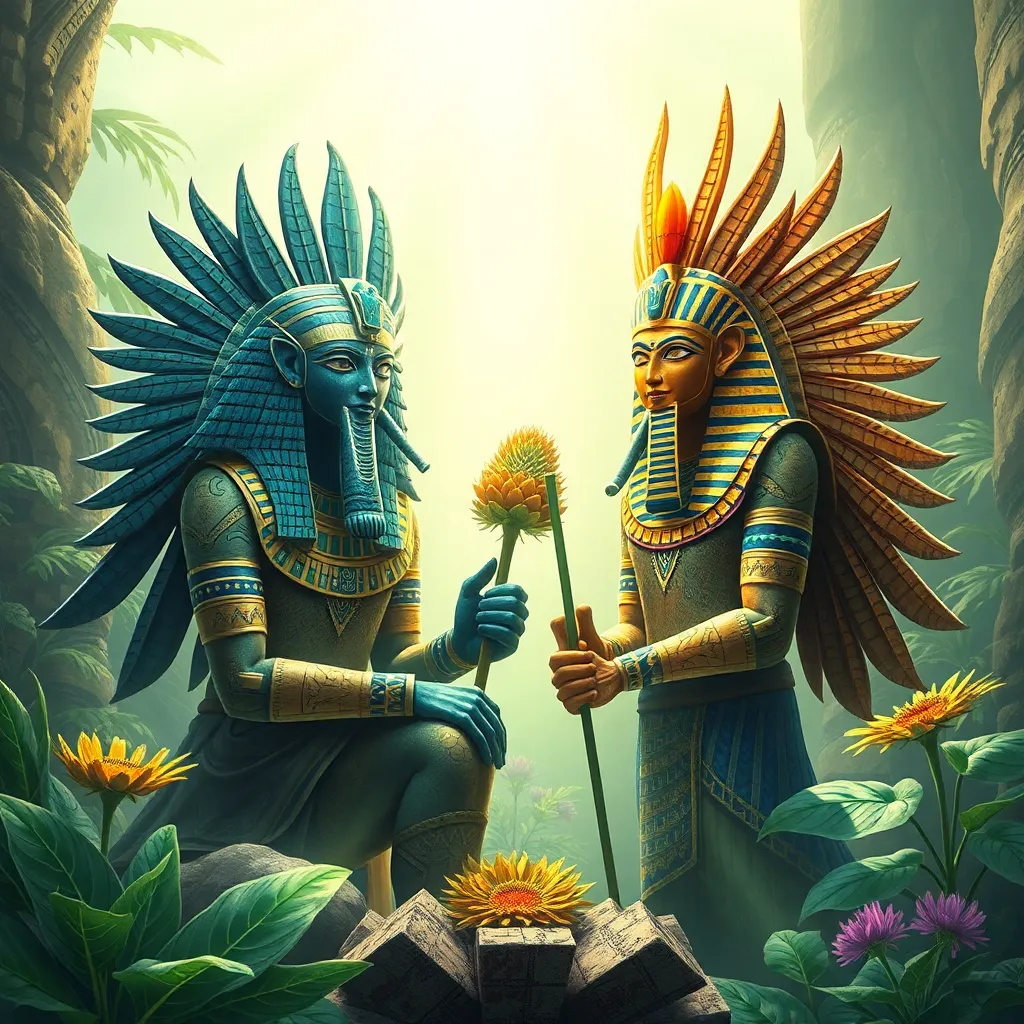Horus and the Sacred Plants: Nature’s Guardians
I. Introduction
In the rich tapestry of Egyptian mythology, Horus stands out as one of the most significant deities. Known primarily as the god of the sky and kingship, he embodies the principles of protection, power, and divine oversight. His mythology is deeply intertwined with the natural world, particularly in relation to sacred plants that played a crucial role in ancient Egyptian culture.
Sacred plants were revered not only for their practical uses in medicine and rituals but also for their symbolic meanings. They were often associated with various deities, including Horus, as they represented life, rebirth, and protection. This article aims to explore the profound relationship between Horus and sacred flora, shedding light on how these elements were interwoven in ancient Egyptian beliefs.
II. The Mythological Significance of Horus
Horus, often depicted as a falcon or a man with a falcon head, is a complex figure with various attributes and symbolism. He is associated with the sky, kingship, and protection, often representing the pharaoh’s divine right to rule. His connection to the sun and the moon further emphasizes his role as a celestial guardian.
As a protector, Horus was believed to safeguard the pharaoh and, by extension, the entire nation of Egypt. His mythological narrative, particularly the story of his battle against Seth for the throne of Egypt, highlights his role as a guardian figure, representing order and justice against chaos.
Within the Egyptian pantheon, Horus occupies a central position. He is often linked with other important deities, such as Osiris and Isis, and his worship reflects the broader themes of resurrection and eternal life that permeated ancient Egyptian spirituality.
III. Sacred Plants in Ancient Egypt
Ancient Egyptians utilized a variety of sacred plants in their rituals and medicine, each carrying unique meanings and associations. Some of the most prominent sacred plants included:
- Papyrus: This plant was integral to Egyptian life, symbolizing the creation of the world. It was used for writing, and its tall stalks represented the marshy lands of the Nile.
- Lotus: The blue lotus, or Nymphaea caerulea, was a powerful symbol of rebirth and creation. It was often associated with the sun god Ra and the cycle of life.
- Sycamore: The sycamore tree was thought to provide protection and nourishment. It was often depicted in tomb paintings as a source of shade and comfort in the afterlife.
The geography of ancient Egypt, particularly its Nile-centric ecosystem, influenced the selection of these sacred plants. The fertile banks of the Nile supported a diverse range of flora that the Egyptians came to revere and utilize in their daily lives and spiritual practices.
IV. Horus and the Symbolism of Plants
Horus’s connection to specific sacred plants is profound, particularly with the lotus flower. The lotus is not only a symbol of rebirth but also embodies the essence of the sun rising above the water, which resonates with Horus’s associations with the sky and light.
In various depictions, Horus is shown with the lotus, symbolizing his role in the cycle of life and the continuity of existence. The lotus’s ability to bloom beautifully even in murky waters parallels Horus’s triumph over adversity and chaos.
Furthermore, plants were integral to Horus’s mythology and iconography, often depicted in temple reliefs and artifacts that celebrated his divine nature and protective qualities.
V. Rituals and Practices Involving Horus and Sacred Plants
Ancient Egyptian rituals often incorporated sacred plants, reflecting their intrinsic connection to spirituality and the divine. Rituals dedicated to Horus frequently utilized flora to invoke his protective presence. Some notable practices included:
- Offerings: Sacred plants like lotus and papyrus were offered at altars to honor Horus and seek his blessings.
- Funerary practices: The use of sycamore wood in constructing coffins was believed to provide protection in the afterlife, linking the deceased with Horus’s safeguarding spirit.
- Healing rituals: Certain plants were used in medicinal concoctions, believed to be blessed by Horus, thereby enhancing their healing properties.
These rituals underscored the belief that Horus not only protected the living but also played a vital role in the transition to the afterlife, ensuring the continuity of existence beyond death.
VI. The Concept of Nature as a Guardian
In ancient Egyptian spirituality, nature was viewed as a powerful force, imbued with divine presence. The Egyptians believed that the natural world was a manifestation of the gods, with Horus epitomizing the guardian spirit of nature. His symbolism as a protector extended beyond humanity to encompass the entire ecosystem.
The philosophical connection between divine protection and ecological stewardship is evident in how Horus is revered as a guardian of both the land and its inhabitants. This relationship emphasizes the importance of harmony between humans and nature, a principle that resonates with contemporary environmental awareness.
VII. Modern Interpretations and Legacy
Today, the influence of Horus and sacred plants continues to inspire contemporary spiritual practices. Many modern spiritual movements draw from ancient Egyptian beliefs, integrating the symbolic meanings of plants and deities into their rituals and philosophies.
Ecological awareness has also been inspired by these ancient beliefs, prompting a reevaluation of humanity’s relationship with nature. Horus’s legacy as a symbol of nature’s guardianship encourages a deeper understanding of the importance of protecting the environment and preserving sacred spaces.
The enduring relevance of Horus serves as a reminder of the interconnectedness of all life and the necessity of stewardship over the natural world.
VIII. Conclusion
The relationship between Horus and sacred plants is a testament to the profound connections that existed in ancient Egyptian spirituality. From the protective attributes of Horus to the symbolic significance of flora, these elements illustrate a harmonious interplay between divinity and nature.
Preserving ancient wisdom in modern contexts is essential, as it offers valuable insights into ecological stewardship and the sanctity of life. The legacy of Horus as nature’s guardian continues to resonate, reminding us of the importance of nurturing our environment and honoring the sacredness of the natural world.




